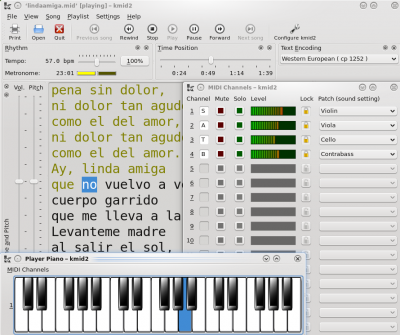KMid2: Difference between revisions
Appearance
New Mandriva RPM package |
New features for 0.2 |
||
| Line 30: | Line 30: | ||
==ChangeLog== | ==ChangeLog== | ||
Coming soon release 0.2 | |||
:* External soft-synths can be automatically launched at startup. A new page including FluidSynth and TiMidity++ settings has been added to the "Configure kmid2" dialog. | |||
:* Each channel may be labeled in a text field besides each channel number. | |||
:* New "lock instrument" button in the channels window to override the song's predefined instruments. | |||
:* Settings per song can be saved and automatically retrieved, including text encoding, volume, pitch, rhythm, channel labels and fixed instruments. | |||
:* The sample songs location is added to the places navigation panel in the open dialog. | |||
:* Several other usability enhancements. Many thanks to the KDE Usability Team for the suggestions. | |||
2009-12-30 Release 0.1.1 | 2009-12-30 Release 0.1.1 | ||
:* Recent files menu | :* Recent files menu | ||
| Line 44: | Line 52: | ||
==Notes for usage== | ==Notes for usage== | ||
:* If you use Timidity++ as a software synthesizer, you may have to install GUS patches or sound fonts. You can find them at [http://freepats.zenvoid.org/freepats freepats] | :* If you use Timidity++ as a software synthesizer, you may have to install GUS patches or sound fonts. You can find them at [http://freepats.zenvoid.org/freepats freepats] | ||
:*[http://www.fluidsynth.org Fluidsynth] is an alternative. It has a helpful gui called [http://qsynth.sourceforge.net QSynth]. For soundfonts, try [http://www.schristiancollins.com/generaluser.php General User GS]. | :*[http://www.fluidsynth.org Fluidsynth] is an alternative. It has a helpful gui called [http://qsynth.sourceforge.net QSynth]. For soundfonts, try [http://www.schristiancollins.com/generaluser.php General User GS]. | ||
:*For more information and options, there is a [[Tutorials/MIDI on Linux|tutorial]] available. | :*For more information and options, there is a [[Tutorials/MIDI on Linux|tutorial]] available. | ||
| Line 83: | Line 84: | ||
::{| | ::{| | ||
|[[Image:Im-status-message-edit.png]]||'''Note'''||This status report has been updated on | |[[Image:Im-status-message-edit.png]]||'''Note'''||This status report has been updated on 12th January 2009 | ||
|} | |} | ||
[[Category:Multimedia]] | [[Category:Multimedia]] | ||
Revision as of 12:47, 12 January 2010
Template:I18n/Language Navigation Bar
 |
Simple Karaoke or getting the best from your Midi Synthesizer! |
KMid 2 is in preparation. As part of Extragear it does not necessarily ship on the same date as KDE SC 4.4, but it is on track for a stable release around that time. Meanwhile, preliminary releases have been published.
So what is the current status?
Currently implemented
Here are some major features implemented in KMid2:
- MIDI and Karaoke files are supported.
- Playback to external hardware MIDI devices.
- Allow to use software synths as well, like Timidity++ and QSynth/FluidSynth.
- Tempo and volume controls.
- Added a pitch (transpose) control.
- Rhythm view (visual metronome).
- Configurable character encoding, font and color for lyrics.
- Playlists (song collections).
- MIDI Mapper, translating General Midi events into other events understood by some synthesizers.
- Channel window, with solo/muting controls and instrument selectors.
- Piano player window, using VMPK artwork and technology.
- Runs in Linux, using the ALSA Sequencer.
What is not yet ready?
- Support for Windows and Mac OSX.
- Multiple MIDI output ports. Currently plays to a single output port.
- Konqueror integration.
ChangeLog
Coming soon release 0.2
- External soft-synths can be automatically launched at startup. A new page including FluidSynth and TiMidity++ settings has been added to the "Configure kmid2" dialog.
- Each channel may be labeled in a text field besides each channel number.
- New "lock instrument" button in the channels window to override the song's predefined instruments.
- Settings per song can be saved and automatically retrieved, including text encoding, volume, pitch, rhythm, channel labels and fixed instruments.
- The sample songs location is added to the places navigation panel in the open dialog.
- Several other usability enhancements. Many thanks to the KDE Usability Team for the suggestions.
2009-12-30 Release 0.1.1
- Recent files menu
- Highlight trimmed syllables, ignoring leading and trailing white spaces
- Allow stop in paused state
- Synchronized with lib. aseqmm 0.2.0
- Assorted fixes
2009-11-30 Release 0.1.0
Demo
See KMid2 in action in this Screencast
Notes for usage
- If you use Timidity++ as a software synthesizer, you may have to install GUS patches or sound fonts. You can find them at freepats
- Fluidsynth is an alternative. It has a helpful gui called QSynth. For soundfonts, try General User GS.
- For more information and options, there is a tutorial available.
Download
- Source packages
- http://sourceforge.net/projects/kmid2/files/
- openSUSE Build Service - Search packages
- http://software.opensuse.org
- openSUSE Build Service - RPM packages for openSUSE
- openSUSE 11.2
- openSUSE 11.1
- openSUSE 11.0
- openSUSE Build Service - DEB packages for xUbuntu
- xUbuntu_9.04
- xUbuntu_9.10
- Gentoo ebuild
- http://packages.gentoo.org
- Mandriva 2010
- http://www.mandrivalinux.gr
Resources
- Some sample .kar and .mid files are installed with the application. Others are available from http://www.mididb.com/ and http://midikaraoke.com/songdir/ . There is a useful search engine at http://www.vanbasco.com/midisearch.html
- If you are interested in building for testing, please read the README
- The source code repository for testing and development is available from here
